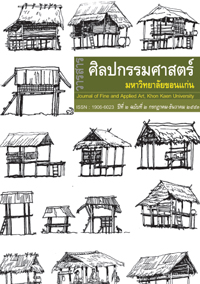นาเด่ง : พิณกะเหรี่ยงจังหวัดกาญจนบุรี
Main Article Content
Abstract
งานวิจัยนี้มีจุดมุ่งหมายเพื่อศึกษาและรวบรวมข้อมูลเกี่ยวกับนาเด่ง พิณกะเหรี่ยงในจังหวัดกาญจนบุรี ซึ่งเป็นเครื่องดนตรีที่สำคัญของชาวกะเหรี่ยงที่มีการสืบทอดมายาวนาน ทั้งนี้ผู้วิจัยได้ศึกษาและเก็บข้อมูลโดยใช้ระเบียบวิจัยเชิงคุณภาพ โดยเลือกพื้นที่ที่มีกะเหรี่ยงโปอาศัยอยู่หนาแน่นและยังคงยึดถือประเพณีและวัฒนธรรมด้านดนตรีใน ๓ อำเภอ คือ อำเภอสังขละบุรี อำเภอทองผาภูมิ และอำเภอศรีสวัสดิ์ มีวัตถุประสงค์เพื่อศึกษารวบรวมองค์ความรู้เกี่ยวกับนาเด่งประกอบด้วย ประวัติความเป็นมา ลักษณะทางกายภาพ ระบบเสียง วิธีการบรรเลง บทเพลง บทบาทหน้าที่ การสืบทอด และนักดนตรี ผลการศึกษาพบว่า
นาเด่ง เป็นพิณ ๖ สาย ปรากฏอยู่ในวัฒนธรรมของชาวกะเหรี่ยงโป จังหวัดกาญจนบุรี ที่อาศัยอยู่ในบริเวณป่าด้านทิศตะวันตกของอุทยานแห่งชาติทุ่งใหญ่นเรศวร ในอดีตแพร่หลายมากในกลุ่มชาวกะเหรี่ยงโปและกะเหรี่ยงสะกอทั้งในประเทศพม่าและประเทศไทยในภาคเหนือและภาคตะวันตก นาเด่งเริ่มแพร่หลายและนิยมเล่นในกลุ่มกะเหรี่ยงจังหวัดกาญจนบุรี ในอำเภอสังขละบุรี เมื่อประมาณ ๕๐-๖๐ ปี ที่ผ่านมา ต่อมาจึงได้กระจายสู่อำเภอต่างๆที่มีชาวกะเหรี่ยงอาศัยอยู่จนถึงปัจจุบัน นาเด่งมีวิธีการบรรเลงและการแต่งคำร้องที่มีรูปแบบเป็นเอกลักษณ์ เพลงร้องประกอบการเล่นนาเด่งของชาวกะเหรี่ยงที่พบในจังหวัดกาญจนบุรีส่วนมากมีเนื้อหาเกี่ยวข้องกับวิถีชีวิต แบ่งเป็น ๖ ประเภท คือ ๑) เพลงเกี่ยวประวัติชนเผ่า ๒) เพลงเกี่ยวกับธรรมชาติ ๓) เพลงเกี่ยวกับประเพณี ๔) เพลงเกี่ยวกับสัจธรรมและพุทธทำนาย ๕) เพลงเกี่ยวกับความรัก และ ๖) เพลงของกะเหรี่ยงเผ่าอื่น แต่เดิมนาเด่งเป็นเครื่องดนตรีที่เล่นเพื่อความบันเทิง ต่อมาได้เพิ่มบทบาทในพิธีกรรมสำคัญของ ชนเผ่ามากขึ้น ได้แก่ พิธีทำบุญข้าวใหม่ พิธีผูกข้อมือ อีกทั้งในปัจจุบันชาวกะเหรี่ยงได้ปรับเปลี่ยนวัฒนธรรมดนตรีของตนเองตามกระแสสังคม โดยได้นำนาเด่งไปแสดงเพื่อธุรกิจการท่องเที่ยวกันมากขึ้น
Na-Deng : Karen Harp in Kanchanaburi Province
The purpose of this research is to study and to collect all information about Na-Deng (Karen Harp) in Kanchanaburi Province, which has been inherited for a long time as an important music instrument. This study in qualitative research. The area of the study is concentrating on those living areas of Karen Pwo that culture and traditions are still maintained. Thus, Sangkhlaburi district, Thong Pha Phum district, and Srisawat district are those chosen area of the study. The purpose of this study is to collect the information and knowledge of its history, physical characteristics, sound systems, playing, songs and lyrics, role and function, heredity and musician, which the study has shown that ;
Na-Deng is a ๖ strings harp. It is still found in Karen Pwo’s culture in Kanchanaburi, who live in the west side of The Wildlife Sanctuary Thung Yai Naresuan. In the past, this harp was also popular not only in Karen Pwo, but also in Karen Sgaw, Bruma, western Thailand and Northern Thailand. In the past ๕๐-๖๐ years, Na-Deng has become a popular music instrument in Karen tribes in Sangkhlaburi. Then, most of Karen tribes, also in those nearby districts, have been playing this instrument up until now. Na-Deng has a certain way of playing and lyrics of the song that shows the identity of Karen. Those lyrics and songs played by Na-Deng usually involves the story of Karen’s life which can be devided into ๖ catehories ; ๑) history of the tribes, ๒) nature ๓) tradition ๔) the truth and Buddha prophesy ๕) Love, and ๖) about other Karen tribes. Na-Deng was originally a music instrument that play for entertaining. Later, it became one of the instrument play in the tribe’s ritual and ceremonies such as the ceremony of making merit for new rice, the ceremony of wrist tying. In the present Karen has developed their musical culture according to the change of society and the influence from outside, therefore, Na-Deng is performed in tourism business and moreArticle Details
Content and information in articles published in the Journal of Fine and Applied Arts of Khon Kaen University is regarded as the opinion and sole responsibility of the author(s) directly; therefore, editors are not obliged to agree to or share any responsibility with regard to the content and information that appears within these articles.
All articles, information, content, image, etc. that have been published in the Journal of Fine and Applied Arts of Khon Kaen University is the copyright of the Journal of Fine and Appllied Arts of Khon Kaen University. Any person or organization who wishes to distribute all or parts of the articles for further dissemination or other usage must first receive permission from the Journal of Fine and Applied Arts of Khon Kaen University before proceeding to do so.


